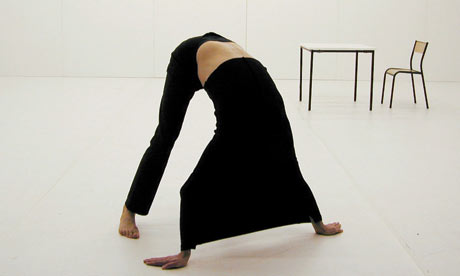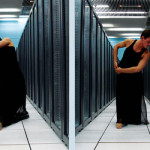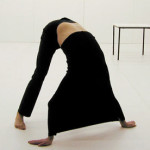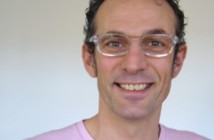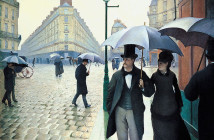Last week, I had the wonderful good fortune of attending two lectures about two different artists who dance with science. On Monday, February 22nd, the MIT Program in Art, Culture and Technology kicked off its spring lecture series with Xavier LeRoy, the french biochemist cum not-so-interpretive dancer. Le Roy is in residence at MIT throughout the semester working with students and researchers, which will result in a performance later on. The very next afternoon I jumped back on the Red Line out to Harvard Square and saw Liz Lerman discuss her work with the scientists at the CERN research facility in Switzerland. LeRoy is a scientist turned choreographer, blending the two disciplines into something almost unrecognizable. Lerman is a conduit between the two disciplines urging artist and scientists to engage in a conversation that will enrich both. Their work proved to be completely different from one another, yet the reasons behind each of their inter-disciplinary processes proved to be more similar than I expected.
Xavier LeRoy was born in France in 1963. He studied biochemistry at the University of Montpellier and then at the age of 25 he began dancing. LeRoy had spent years working in a lab conducting many experiments hoping to arrive at a predetermined hypothesis before he made his career change. Always athletic, he was and is fascinated with the machinery of the human body, in particular the fact that his adult body could not seem to perform the movements he saw embodied in modern dance. Understandably, his artistic practice was informed by his work in science and he began to experiment with just what his body could do. In his performances LeRoy moves his limbs and body in ways that completely de-familiarize the viewer from how we generally conceive of a body—and especially a dancer-- should move.
In his performance Self-Unfinished (1998) (which will be performed at the ICA this upcoming April), the viewer sees LeRoy seated in a chair wearing a black shirt and black pants. Throughout the course of the performance he pulls his shirt up to cover his head. The shirt has two parts, one that remains over his midsection and obscures his torso and another part which covers his arms, shoulders and head. This prop, the shirt, serves to obscure the physical characteristics the viewer uses to identify the torso. He begins to move around the stage on his hands and feet, placing his hands in the same position his feet are in. In the final stage of the performance LeRoy is naked. Showing only his back to the audience, he is seated on the stage with his head bowed to his chest and his legs tucked in front of him completely out of view. Viewed from behind, the shape of his shoulders appear virtually the same as the shape of his buttocks. LeRoy embarked on these performances with a hypothesis: He proposed that the human form becomes unfamiliar if the characteristics that we use to organize a body in our mind’s eye are removed. As he rehearsed his performances he carefully observed what elements of the body are leg-specific or arm-specific. In an experiment involving the mechanics of the human body the mind assumes that the arms and the legs move in different ways because of their specific functions as they pertain to human anatomy. Arms move the way they do because of their proximity to the shoulders, neck and head etc. By removing the factor on which the arms are supposedly contingent, LeRoy allows the mind to imagine different things about what movements the human body is capable of creating.
Liz Lerman began her work with science after a long career of using art and dance as a catalyst for social change. She founded the Liz Lerman Dance Exchange in order to bring dance to a wider audience, with that group traveling the country performing the multi-media dance production Ferocious Beauty: Genome. After the success of that project a physicist from the University of Michigan approached her about coming to the CERN research facility outside of Geneva, Switzerland to create a dance project about theoretical physics. CERN is the European Organization for Nuclear Research, where the world’s largest and most complex scientific instruments are used to study the basic constituents of matter — the fundamental particles. By studying what happens when these particles collide, physicists learn about the laws of Nature. Lerman believes passionately that artists should be resources for other disciplines, that science is not black and white, and if one considers the distinct processes of conducting scientific experiments and creating art, one naturally informs the other. In her work at CERN, and throughout her career, Lerman uses dance to translate the often dry and acerbic world of science into a more emotional language.
The images of a lone dancer making his way through the massive halls and tunnels of the Large Hadron Collider (LHC) bring the concept of theoretical physics to a place where we can feel with our senses, rather than intellectually. The dancer embodies the concept of the atoms careening and caroming through this massive space. One scene shows a dancer trying to pass through a wall. The viewer knows from a scientist’s narration that atoms can pass through objects like walls, and here we see a dancer embodying this idea. We know logically that the dancer will never move through the wall because it’s massive and made of cement, but the clip isn’t long enough for us to see him give up. As we watch the man try to climb the wall over and over again, the implications about the relationship between humans and atoms are undeniable. If we are all made of atoms, and atoms can move through walls, then why can’t this man move through this wall? What holds us together and prevents us from passing through other objects? In the future, will we separate our atoms enough to pass through walls? The viewer is brought to the same questions that occupy the scientists at CERN with the dancer embodying a concept more successfully conveyed through performance than dry explanation.
LeRoy's and Lerman's presentations were as different as night and day. LeRoy’s was meticulously planned and laid out in a PowerPoint document with bullet points, theses, hypothesis and conclusions. He sat behind a table with a laptop and carefully outlined his work while showing the audience clips of his performances. Each performance was practiced and repeated exhaustively, in some cases using mirrors, at other moments he used cameras. He repeated his corporeal experiments time and time again until he believed he had reached a “conclusion”. When asked questions he seemed almost unsure, but worked hard to find the correct word in English to express himself fully. He was worried about how long he was taking. Lerman essentially floated into the lecture hall. She sat in front of the audience and as a viewer I was immediately engaged by her presence. As she spoke she used her hands to emphasize her words and the lines she created while talking were a dance performance unto themselves. She spoke emphatically and elegantly about the position of art in society and has inspired countless dancers, scientists and layman with her passion. Despite differences, each artist agrees: art and science work better in concert.
LeRoy grew frustrated with being a researcher because, as he put it, “there is no room for play”. Science is a field that places emphasis on results and often overlooks the importance of the experiment itself. Weary of being a slave to the bottom line, LeRoy pursued a career where the process itself became the work. His performances are uncanny as he injects the dry analytical methodology of experimentation into the predominantly aesthetic world of dance. Where we usually see grace and beauty, we are confronted with an alien form that our mind grapples to comprehend and recognize. The two disciplines of art and science have such a potential to inform one another, as the practice of creating them is so very similar. Both require enormous amounts of trial and effort, with a willingness to make mistakes in order to achieve success. In both cases, the public often requires a result to measure success. The frustrations inherent in both fields are almost identical.
- Ben Wegman moves down an aisle of server racks at CERN’s Computer Center. Photos: Amelia Cox
- Still from Xavier Le Roy’s “Self-Unfinished.”
Xavier Le Roy
Liz Lerman Dance Exchange
Xavier LeRoy's "Self-Unfinished" will be performed at the ICA on Friday, April 2nd, 7:30 pm.
All images are courtesy of the artist.

